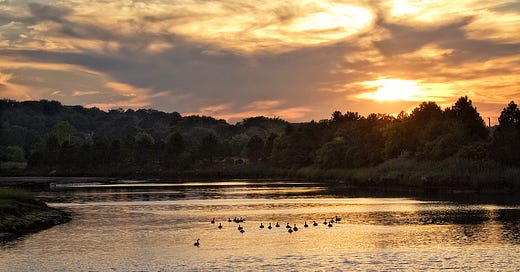I grew up in a town about 15 minutes north of Boston, Massachusetts, called Saugus. Saugus was founded by European settlers in the early 1600s. According to Wikipedia, for thousands of years prior to the arrival of Europeans, the land was inhabited by Native peoples called the Naumkeag, who were also known as the Pawtucket. The word “Saugus” or “Sagus” is, in fact, a Pawtucket term meaning “outlet,” and was chosen in reference to the Saugus River—a tidal river that flows through town and all the way to the Atlantic Ocean just a few short miles away.
In school, we never learned about the Native people. I did not know what they were called, or what the word Saugus meant, until about five minutes ago when I looked it up on Wikipedia.
Growing up, we knew there must have been Native people in the area at some point because kids would pretty regularly find arrowheads while playing in their backyards. Oh, and our high school mascot is (to this day) the Sachem—our cheerleaders wore Native-inspired uniforms up until at least 1992. This last fact is particularly, uh… interesting(?) when you learn that, according to the Town of Saugus website, the racial demographics of the town break down like this:
“93.3% White, 2.7% Black or African American, 0.05% Native American, 3.1% Asian, 0.1% Pacific Islander, 2% from other races, and 1.6% from two or more races. Hispanic or Latino of any race was 4% of the population. The U.S. Census also shows that 36% is of Italian descent, and 24% is of Irish descent dominating the Town.”
To be fair, except for the requisite field trip to our locally famous Saugus Ironworks, founded in 1646, we also never really learned about any of the other history of Saugus either. While reading the Wikipedia page, I learned that the town used to have a harness racing track, an airport, and three stops for passenger trains along the Saugus Branch Railroad. I also learned that after the Civil War, one neighborhood of Saugus became a major tobacco producer. Who knew!
While it was interesting to learn a little about my hometown, this post isn’t really about that place specifically.
It’s such a curious thing to me how much can be collectively forgotten about the places that influence and shape us.
We both intentionally forget because we don’t want to remember (what happened to the Naumkeag?), and unintentionally forget because life keeps evolving and time keeps rolling on (we simply didn’t need the passenger trains after the Route 1 highway was expanded for more cars in the 1950s).
And yet, how a community organizes itself—what it prioritizes, what kind of geography it sits on, its military or settler legacy, what other types of communities it resides near, how it fits into the greater socio-economic landscape, the wider geopolitical climate, and so much more—influences generation after generation of people who grow up there.
And we live our lives through that lens without even knowing it.
Until one day, perhaps, we bump up against it.
I bump up against my Saugus upbringing on a pretty frequent basis. I grew up there from the late ’70s through the early 2000s.
How I was shaped by the specific culture of that place during that specific time shows up in all sorts of ways, such as:
What I believe about myself, how I carry myself in my body, and how I experience the world as a white person and a woman. It informs how I approach opportunities, how I think about money, safety, belonging, and whether or not I’m worthy or good enough. It shows up in how I experience other people, and what I notice in the world around me, both at home and when I travel. And while I have reclaimed most of my Rs, my Saugus upbringing most definitely continues to inform how I speak, along with what I say and why I say it.
And that’s just the tip of the iceberg.
And that’s without knowing much at all about the history of the place I’m from or how it came to be the way it is.
Like many people who’ve left their community of origin, I have a complex relationship with the place that I’m from. And that’s totally OK.
From the most basic coaching perspective, the ultimate question is simply: Who do you want to be and why?
To answer this question, you need to take a look at the parts of you that hold you back from becoming this person, the parts of you that propel you toward becoming that person, and the parts of you that are already that person.
You don’t have to do a deep dive on the history of your hometown.
But…understanding and bringing awareness to the factors that have shaped us throughout our lives—including, but not limited to the place we are from, creates space to explore whether or not we want to continue to be shaped by them.
Then you get to decide:
What do you need to let go of? What beliefs or behaviors need to be changed, updated, or reframed? What parts of your history or culture would you like to more fully embrace and embody?
Now, how does this show up for you?
Do you know much about your hometown? As you read this, what connections did you make about how your place of origin shapes who you are to this day? How would you like to embrace more of that part of you? What would you like to change?
I’d love to hear from you!
Reply to this email with your thoughts. All replies are private and come directly to me.
Or feel free to book a friendly chat to share your thoughts, or a discovery call to talk about how we might work together to help you do this work to become who you truly want to be. <3
Looking forward to hearing your stories!







I love this! Great reflection.